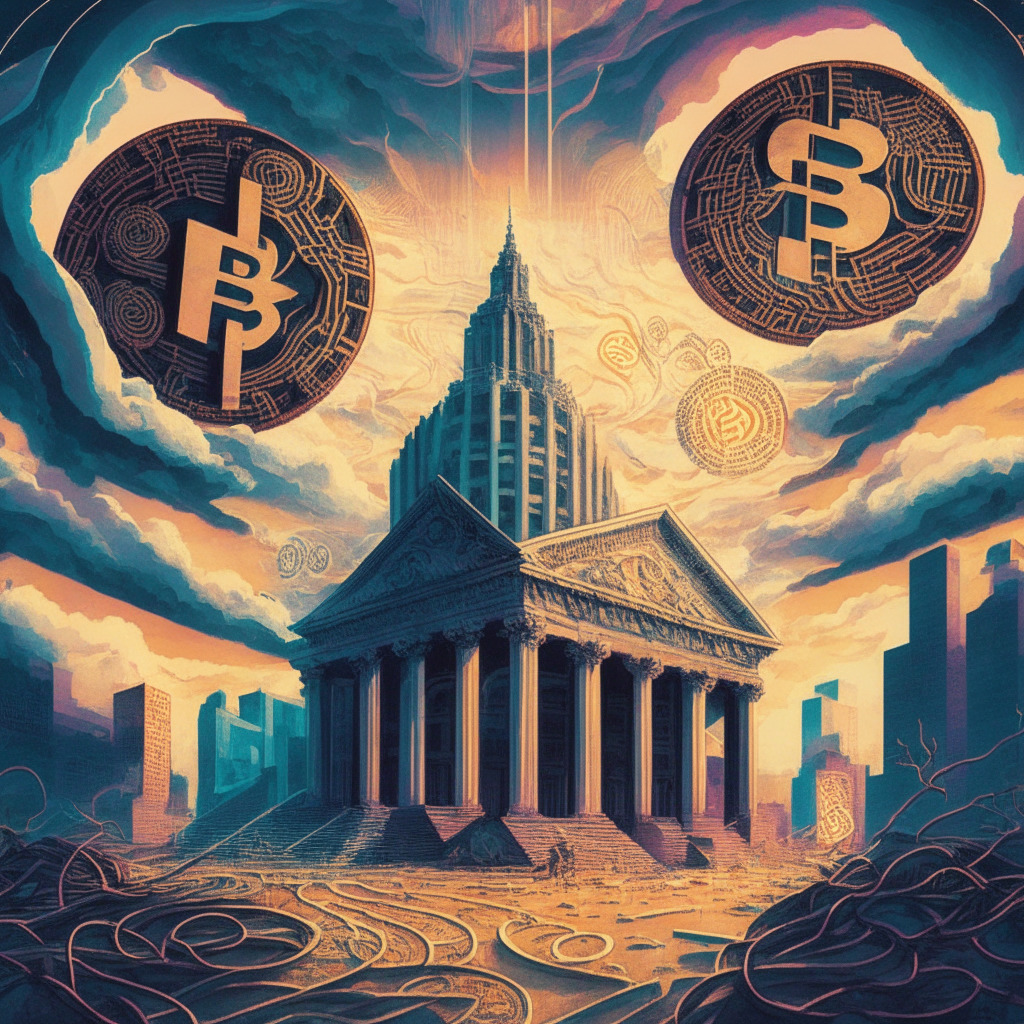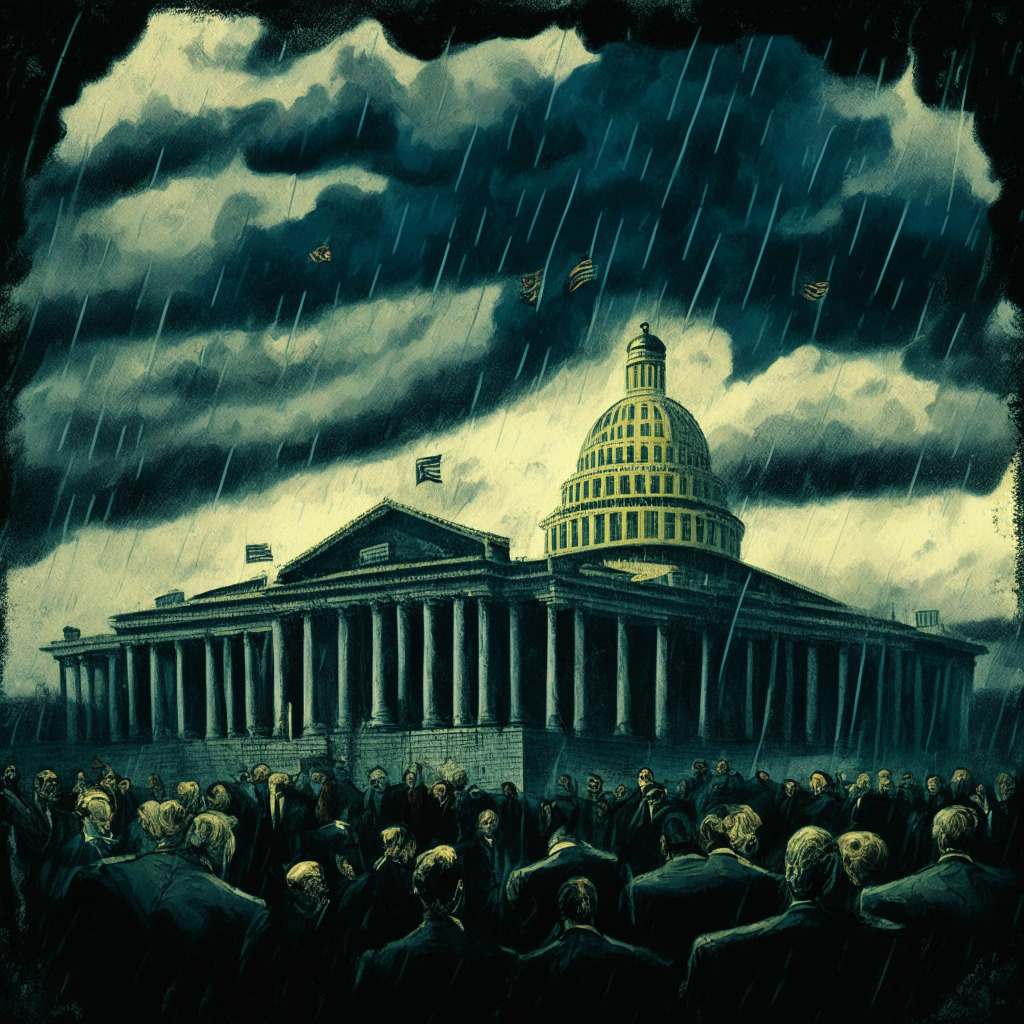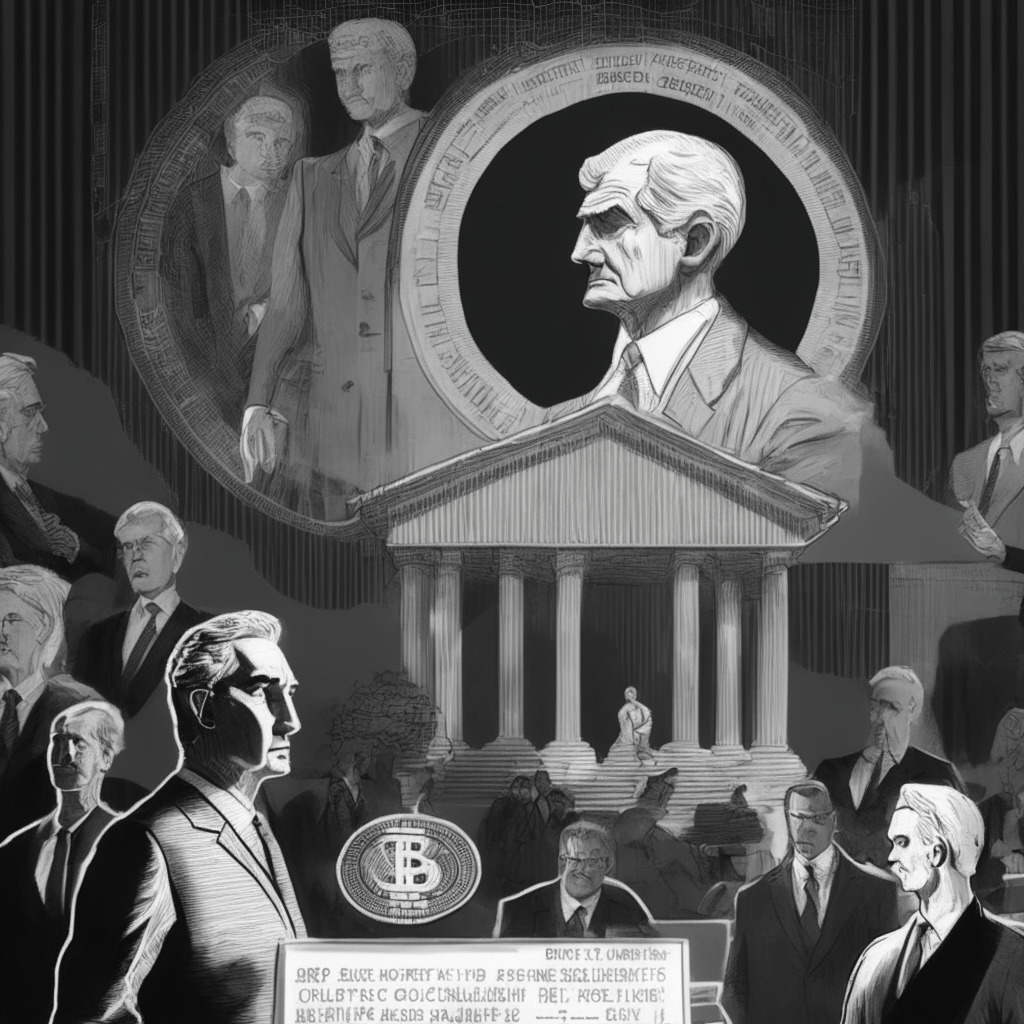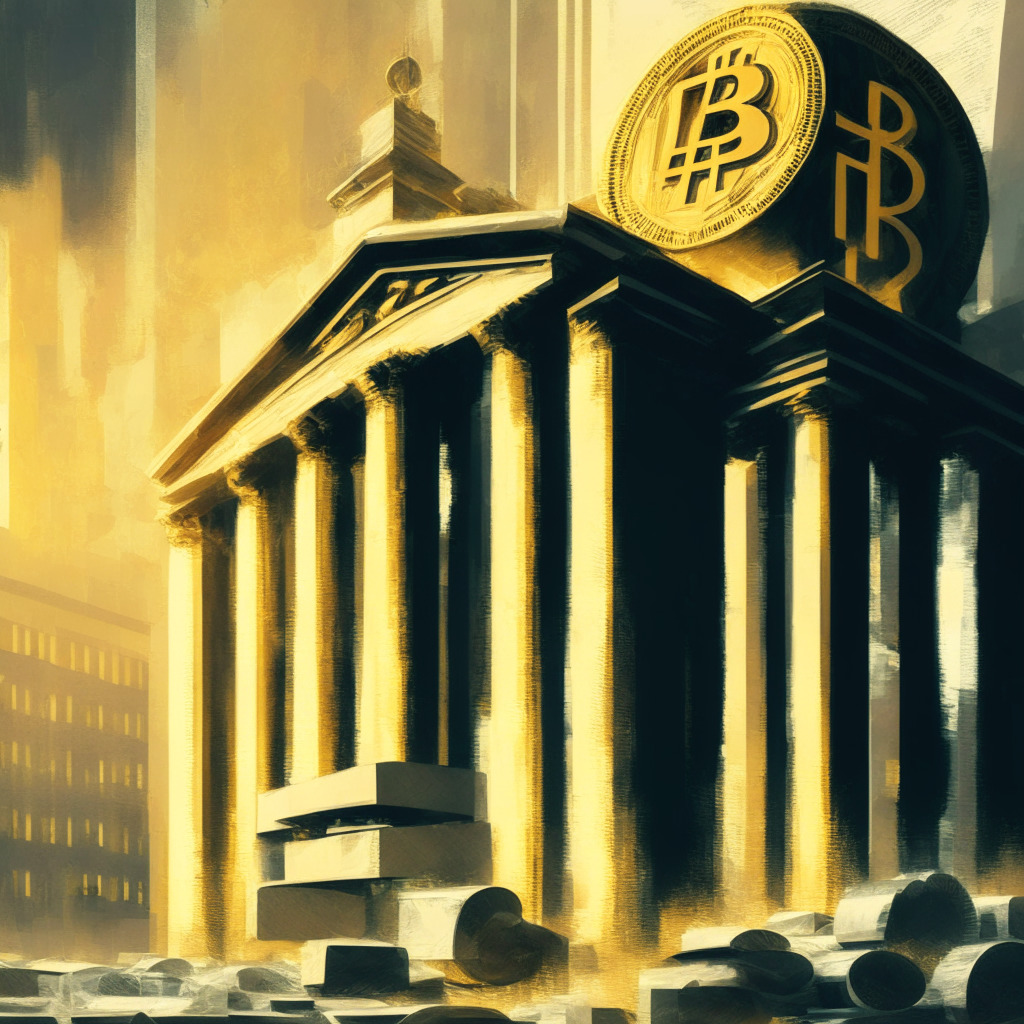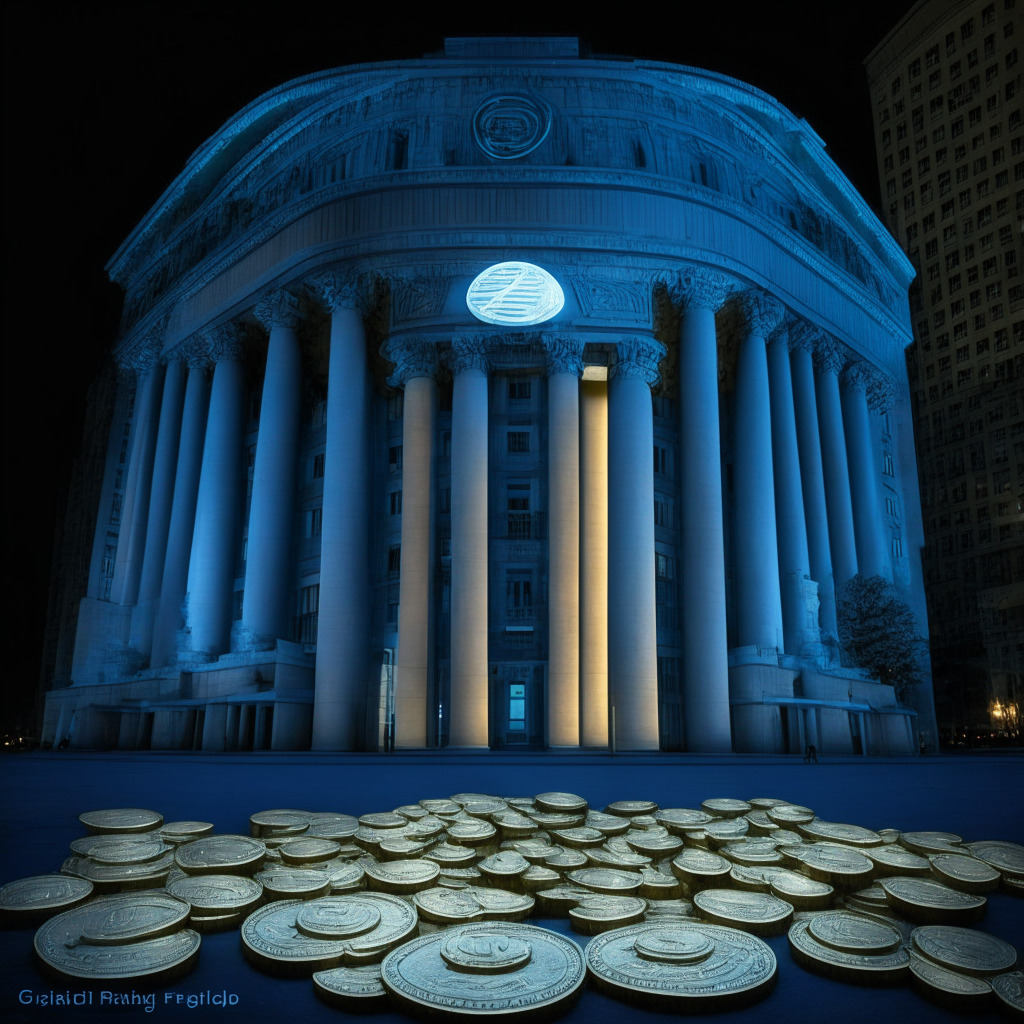The recent data from U.S. Bureau of Economic Analysis shows a decrease in the core PCE inflation index to 3.9% in August, leading to positive investor sentiment. However, potential monetary policy shifts and hints of rate hikes to control inflation cause market sensitivity. Increasing energy prices and inflation uncertainties further complicate Federal Reserve’s monetary policy considerations.
Search Results for: Federal Reserve
Federal Reserve Concerns: Stablecoins’ Instability or the Next Financial Evolution?
“Federal Reserve Banks express concern that stablecoins could introduce instability into the financial system due to lack of standard regulatory framework. The Central Bank of Italy reinforces stablecoins’ unstability and presses for international regulatory body to govern cryptocurrencies. Despite risks, blockchain-based cross-border payments show promise of cost-effective solutions.”
Exploring the Relationship between the Federal Reserve and Bitcoin: Shifts, Correlations, and Projections
The Federal Reserve’s decisions are impacting Bitcoin, causing a 4% value decline over the week. This dip coincides with unchanged federal interest rates. Observers note an increasingly inverse correlation between Bitcoin and the U.S dollar. However, Bitcoin enthusiasts anticipate growth from potential Bitcoin ETF approval.
Navigating Bitcoin’s Rollercoaster: The Impact of Federal Reserve’s Actions and China’s Climate
Bitcoin slipped below the $27,000 mark due to potential interest rate hikes, showing a tense atmosphere in the global crypto market. However, Bitcoin’s hopes lie with the potential approval of SEC for spot Bitcoin ETFs, which could boost Bitcoin’s price by around 20%. Despite stricter capital controls and a sluggish economy in China, the country may offer an interesting solution for Bitcoin’s recent dip. The future for Bitcoin appears uncertain yet thrilling, highlighting the importance of understanding the intricate dynamics of the cryptocurrency market.
Crypto Market Cap Surges: Ties to Inflation Data and Federal Reserve Rates
Cryptocurrency market capitalization has risen by 1.24%, reaching $1.035 trillion as of September 14, largely due to gains in Bitcoin, Ethereum, and Solana. This increase reflects eased inflation concerns and speculation surrounding a potential pause on Federal Reserve interest rate hikes. Additionally, solid fundamentals or promising technical analysis have led to gains in other cryptocurrencies such as Hedera, Wall Street Memes, THORChain, Bitcoin BSC, and Curve DAO.
Wyoming Stablecoin: Game Changer for Federal Reserve or Risk to Monetary Stability?
“The Wyoming Stable Token Act introduces the concept of state-based unique stablecoins, raising questions about their potential to disrupt the Federal Reserve’s authority or revolutionize digital transactions. The future of such state-specific cryptocurrencies is entwined with the ongoing evolution of digital currencies.”
Bitcoin Volatility Correlation Flips: Predicting Potential Declines Amid FTX and Federal Reserve Concerns
Bitcoin’s price and its 30-day implied volatility have resumed a negative correlation, hinting at expected declines. Rising volatility and falling price indicate a bias for protective measures against price slides. Concerns involve potential liquidations by FTX, monetary restrictions by the Federal Reserve, and fears of global monetary tightening. This shift in volatility trend could impact the broader crypto market.
The Paradox of Rate Hikes: Federal Reserve Tactics, BitMEX Perspective and the Emergence of the AI-Crypto Ecosystem
In a keynote at Korea Blockchain Week, Arthur Hayes, the founder of BitMEX, argued that Federal Reserve’s tactics to combat inflation could inadvertently fuel economic growth. He also predicted the potential of AI companies and a significant asset bubble resulting from the convergence of AI, crypto, and money printing.
Federal Reserve Impacts on Bullish BTC and Ethereum’s Centralization Struggles
Arthur Hayes, former CEO and co-founder of Bitmex, anticipates a response to the BTC bull market within six to twelve months. This expectation is connected to the Federal Reserve’s $25 billion program meant to stabilize the U.S. banking system. Meanwhile, Ethereum faces challenges around the centralization of nodes and scalability.
Shackles or Safeguards? Federal Reserve’s Crypto Oversight Fuels Global Expansion
The Federal Reserve’s intensified scrutiny of banks’ cryptocurrency activities has sparked criticism from Republican lawmakers who argue this deters institutions from participating in the digital asset landscape. The Fed’s new requirements may potentially suppress the progress of decentralized finance. Amidst this, U.S. regulations on digital assets remain unclear, pushing some crypto companies to explore alternative markets overseas. The discourse focuses on balancing effective supervision with fostering blockchain innovation.
Federal Reserve’s Tightened Grip on Crypto Sparks Republican Lawmakers’ Concerns
Republican lawmakers express concerns over the Federal Reserve’s intensified oversight on crypto and stablecoin activities, arguing it might block the progress of a legislative proposal aimed at regulating stablecoins. Lawmakers believe the increased scrutiny might dissuade financial institutions from entering the digital asset ecosystem.
Navigating the Crypto Maze Amid Federal Reserve’s Fight Against Inflation
“Jerome Powell underlined the struggle against inflation, necessitating continuous aggressive rate hikes. Amidst this, attention spiked on Bitcoin but market warnings intensify. Cryptocurrencies present potential opportunities having strong fundamentals and positive technical analyses, yet they remain a high-risk asset class.”
Bitcoin’s Future: Influenced by Federal Reserve Policies or Independent Market Stalwart?
“The co-founder of BitMEX, Arthur Hayes, shares an optimistic view of Bitcoin’s future, driven by critique of Federal Reserve’s contentious strategies. Bitcoin is seen as an antidote to banking anomalies, growing fiat liquidity, and may face potential surges or falls.”
Federal Reserve vs. Bitcoin: Predictable Paths and Uncertain Futures in Economic Stability
At the annual Federal Reserve gathering in Jackson Hole, chairman Jerome Powell’s policy foretells an uncertain economic future. This unpredictable, human-driven system contrasts with the mathematical certainty of cryptocurrencies like Bitcoin. However, the decision between fiat and cryptocurrency still lies in the hands of individual investors.
Bitcoin’s Chilly Wave: Market Effects, Reactions and Future Predictions Amid Federal Reserve Statements
The cryptocurrency market plunged as Bitcoin fell below $26,000, triggered by U.S. Federal Reserve Chair’s statements on countering inflation and possible rate hikes. Leading altcoin Solana also dipped 3%, and MKR saw a 4% decrease due to fears of a loan default. However, despite the gloomy outlook, experts like Sacha Ghebali believe the market could see an upturn if a spot bitcoin ETF is approved, offering a possible crypto market recovery.
Federal Reserve Meeting Affects Bitcoin and Ether Values: Crypto Exchange Boosts Liquidity Security
“Bitcoins remain steady as attendees anticipate Jerome Powell’s speech in Jackson Hole. Expectations are tempered, however, by Bank of America’s doubt for strong policy directives from the meeting, causing Bitcoin and Ether values to slip. Meanwhile, Binance seeks to boost liquidity security for low-liquidity token crypto projects and new stablecoin nCOP is introduced on the Polygon network in Colombia.”
Decoding Federal Reserve’s Stance on DLT: Is It an Endorsement or Bare Necessity?
“Distributed Ledger Technology (DLT) becomes increasingly significant in financial future with FedNow featuring Dropp, a micropayments platform built on Hedera Hashgraph DLT. However, the Federal Reserve’s stance remains neutral, neither supporting nor endorsing DLT-powered companies, eliciting polarized opinions from the crypto community.”
Federal Reserve’s Potential Rate Cuts: A Bullish Future for Bitcoin?
“There is a growing sentiment that the Federal Reserve may turn toward rate cuts, which could bode well for Bitcoin. This, along with expected spot Bitcoin ETF approvals, could boost Bitcoin prices; however, these developments are not likely to materialize before early 2024.”
Federal Reserve’s Cryptocurrency Supervision: A Barrier or a Blessing?
“The Federal Reserve’s program to monitor lender interactions with cryptocurrencies balances dynamic progression with risk exposure, aiming to preserve banking system dependability. Despite potential restriction, the crypto sector remains potent with income-generating coins. Yet, the high-risk nature of cryptocurrencies necessitates caution and prudent harnessing of multiple indicators for successful trading decisions.”
Crypto Market and Economic Impacts: How the CPI, Federal Reserve Moves and Inflation Rate Shape the Future
The crypto community anticipates the economic impacts of the upcoming Consumer Price Index release, which will likely influence Bitcoin and other cryptocurrencies’ value. Additionally, the Federal Reserve plans to supervise banks’ crypto-related activities through dedicated digital asset experts, aiming to ensure safe and sound operations. Meanwhile, Binance has acquired operation licenses in El Salvador to bolster its global legitimacy.
Federal Reserve’s Crypto Oversight: Balancing Innovation and Regulation
The U.S. Federal Reserve is extending oversight of banks involved in the crypto and blockchain sector with the Novel Activities Supervision Program. It aims to balance innovation with risk management, covering crypto-related services including custody, lending, and trading. This move raises questions about the intersection of banking, regulations, and the emerging crypto domain which could shape blockchain’s future.
U.S Federal Reserve Steers into Crypto: Balancing Innovation with Regulation
The U.S. Federal Reserve is stepping into the crypto industry, establishing a supervision program for banks’ crypto involvement. Although current rules remain unaltered, the approach for oversight has been defined. This move indicates the Fed’s interest in harnessing digital assets’ potential but with keenness to mitigate risks involved. Such actions could potentially lead to tighter crypto regulations.
Decoding the Complex Dance of Job Growth, Federal Reserve Policies and Bitcoin’s Trajectory
“The U.S. economy added 187,000 jobs in July, slightly lower than predictions. The job growth had a minor influence on Bitcoin’s price, showing some responsiveness of crypto market to macroeconomic indicators. Yet, the crypto market continues to evolve uniquely, potentially serving as a global alternate currency.”
US Federal Reserve’s Interest Rate Hike: Its Impact on Crypto and the Global Economy
“The recent 25 bps hike in US Federal Reserve’s interest rates has sparked various opinions among market watchers. Despite this, crypto prices such as BTC, ETH, and SOL showed positive movements, sparking a medium-term positive bias for BTC.”
Bitcoin’s Resilience to Federal Reserve’s Interest Rate Hike: Examining the Interplay
Despite recent Federal Reserve’s interest rates hikes, Bitcoin has shown considerable resilience, maintaining price stability. The crypto market, even considered a separate entity, is influenced by traditional financial systems’ decisions. The story highlights the interplay between cryptocurrencies and conventional financial scenarios.
Federal Reserve, Inflation and Crypto: A Delicate Dance Amid Economic Flux
“The FOMC meeting is expected to continue the trend of increasing interest rates due to persistent inflation concerns. Meanwhile, despite macroeconomic shifts, Bitcoin and crypto markets remain stable. The Fed’s attempts to align a thriving job market with price reduction strategies pose considerable challenges.”
Federal Reserve’s CBDC Hunt: A Financial Death Star or Leap Towards Progress?
“The San Francisco Federal Reserve Bank’s job posting for a “senior crypto architect” has sparked criticism. There are concerns CBDCs could be misused as tools for coercion and control. Representatives like Warren Davidson contend CBDCs should prioritize being a stable store of value and an efficient means of exchange, rather than being used for surveillance and control.”
Navigating Bitcoin’s Price Volatility: Impact on Altcoin Market and Anticipation for the Federal Reserve’s Decision
Bitcoin’s ongoing price struggle against overhead resistance may be prompting interest in other cryptocurrencies. However, the market scenario remains uncertain pending a potential Fed rate hike and volatile investor behavior. This uncertainty underscores the complex interplay of market trends, financial policies and investor behavior in determining cryptocurrency market outlook.
Bitcoin’s Tense Brawl with the $29,500 Support Level: How the Federal Reserve Meeting Could Revive It
Bitcoin continues to hover around the $29,500 support level amid a lack of major economic events or institutional adoption updates. Traders are closely monitoring BTC’s 21-Day Moving Average, a critical barrier for short-term gains. Meanwhile, upcoming Federal Reserve policy changes could trigger movement in Bitcoin markets. Optimism about potential institutional adoption, positive technical indicators, and easing financial conditions could drive Bitcoin’s performance.
Decoding FedNow: U.S Federal Reserve’s Stand on CBDCs and Future of Instant Payment Services
The U.S. Federal Reserve’s new instant payment service, FedNow, set to launch in July 2023, is not associated with central bank digital currencies (CBDCs), but operates within the fiat ecosystem. Despite testing by numerous institutions and growing CBDC interest globally, the Federal Reserve reiterates, it requires legislative authorization before issuing a CBDC.
Intriguing Possibilities for Bitcoin’s Future: AI’s Currency and a Market Influenced by Federal Reserve Projections
The ex-CEO of BitMEX, Arthur Hayes, argues Bitcoin’s potential to be the go-to currency for artificial intelligence due to its constant availability, digital makeup, and automation. Bitcoin stands out with its scarcity, censorship resistance, and value storage. Bitcoin’s market value is also closely tied to investors’ interpretations of the Federal Reserve forecasts and employment data.
How Federal Reserve Meetings Impact Cryptocurrency & Up-and-Coming Meme-Based Tokens
“The crypto markets are currently retreating somewhat, with Bitcoin and Ether slightly down. Market volatility is affected by various factors including macroeconomic considerations and the dynamics of ‘meme’ coins. Formulating a balance and understanding potential risks and rewards is key in this unpredictable investment landscape.”









